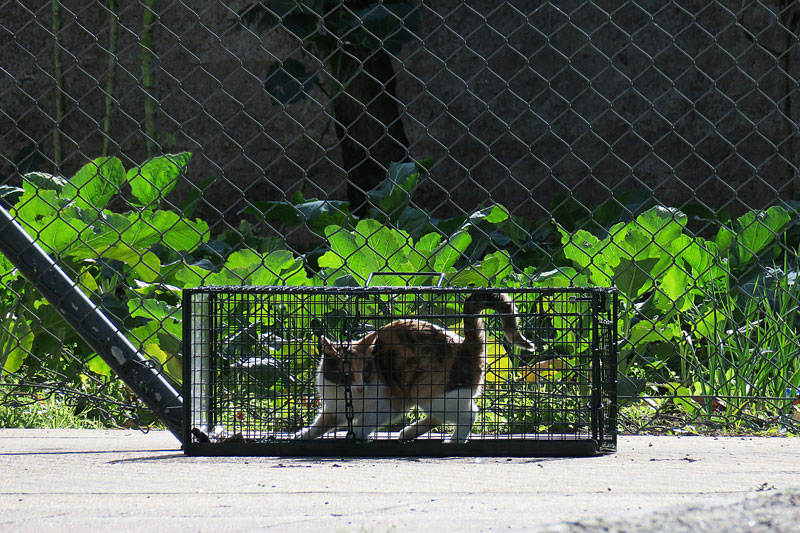Trap, Neuter, Return (TNR)
What is TNR?
How does TNR work?
Trap
Traps are used because most of the cats are not able to be handled by people sufficiently to be placed in a carrier and can cause serious injury through bites and scratches. These traps do not harm the cats.
Neuter
Neutering (also called castration for males and spaying for females, or sterilization, altering, fixing or de-sexing for both) is carried out by qualified veterinarians and ensures that the cats do not continue to reproduce and the associated behaviour (ie fighting, male urine spraying, night-time noise etc) that communities complain about is reduced.
The TNR process also includes identification of neutered cats by cutting off the tip of the left ear under anaesthetic (referred to as ear tipping). This allows cats to be identified from a distance and ensures they are not trapped again for neutering. In many cases the ear tip serves as a trademark and, particularly in the USA, is seen as a sign of a safe and cared-for colony.
Return
Returning the cats to their original site keeps them in a familiar territory and their presence acts as a deterrent to other cats who may be attracted by the food source.
It is important to:
- Monitor the colony of cats to make sure that any new arrivals are trapped and neutered
- Continue to monitor the cats for signs of illness or injury and take action
- Clear food waste and deal with any problems quickly to ensure the local community is happy with the continued presence of the cats
- In some countries, you may also need to clear faecal waste

The traps used in TNR do not harm the cats (source MDC)
How many cats within a colony need to be neutered to be effective?
The aim should be to neuter 100% of the cats in the colony; however:
- A minimum rate of 75% is needed to achieve a reasonable reduction in population
- In many cases, the resources may not be available for a high initial neuter rate (meaning as close to 100 % of cats as possible within the colony are neutered with maximum effort). This may be due to lack of equipment, vet capacity or manpower. In these cases, 40% initial neutering followed up by a repeated 40% every 6 months may also work
- Any new cats arriving in the colony must be neutered
- Other colonies close by may need to be included to ensure success
- The effectiveness can be maximised by doing as much trapping and neutering as possible in the early stages, perhaps by bringing in more veterinarians and people who can do the trapping to help initially
- Cats which have evaded trapping will require greater effort as they become more suspicious of the traps
- In addition, neutering of owned pet cats to a high rate (85-90% of the total population) should be encouraged to prevent the unowned population increasing by the addition of abandoned unwanted kittens or adult cats that owners no longer want due to their reproductive behaviour
On rare occasions cats may have to be released at a new site because their original one is not able to be used – an area is being built on, for example. Finding new sites can be difficult and the cats may have to be trapped and relocated in small groups as sites become available. This is a last resort and needs careful preparation and planning to acclimatise the cats to their new environment and carers.
There will be a time lag in TNR population reduction compared with removal methods such as culling (often using poison or other inhumane methods) because the cats are returned as long as they are healthy, but obviously cannot reproduce. If incoming new cats are neutered, numbers will stabilise or reduce as cats eventually die. The benefits are improvement in cat welfare and a gradual decrease in the size of the population if it is managed well. If reproduction is prevented people can enjoy having healthier cats in the area and do not have to be traumatised by the sight of sick or dying kittens.
Typically, the impact on population becomes noticeable over the first 2 years and can take up to 10 years to stabilise. If the population is not managed over time, however, it is likely to increase again.
| Key information:
There are a number of different ways to describe what is fundamentally the same process but with local variation linked to particular situations according to resources and views about cats. Below are the most commonly used alternative terms to TNR:
|
| Useful resources:
A study in the USA found that less than 1% of the 103,643 stray and feral cats examined in neutering clinics in six states from 1993-2004 needed to be euthanised due to trauma, infectious diseases or debilitating conditions. Wallace, Jennifer L, and Julie K Levy, “Population Characteristics of Feral Cats Admitted to Seven Trap-Neuter-Return Programs in the United States,” Journal of Feline Medicine and Surgery 8 (2006): 279-284. Deciding on the best management option for free-roaming cats is always a challenge. This study, published in November 2021, used computer simulation modelling to estimate and compare costs of different management options and their ability to reduce free-roaming cat numbers. The simulations suggested that cost-effective reduction of numbers required intense management, regardless of approach, together with minimizing cat abandonment. Removal of cats yielded the fastest initial reduction in numbers, but TNR was a viable and potentially more cost-effective approach if performed at high intensity over a sufficient duration. Of those management scenarios that reduced the final population size by approximately 45%, the three scenarios that relied exclusively on removal were considerably more expensive than the two scenarios that relied on neutering. Benka VA, Boone JD, Miller PS, Briggs JR, Anderson AM, Slootmaker C, Slater M, Levy JK, Nutter FB & Zawistowski S. Guidance for management of free-roaming community cats: a bioeconomic analysis. Nov 2021 J Feline Med Surg. |



